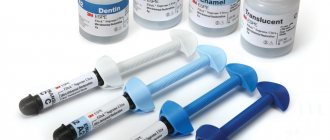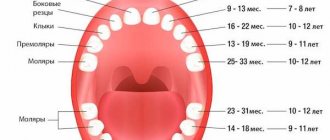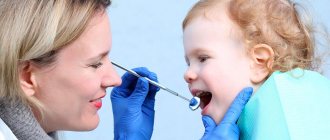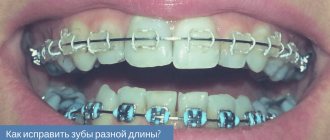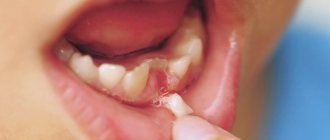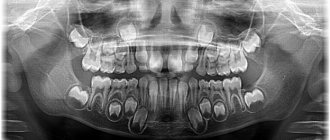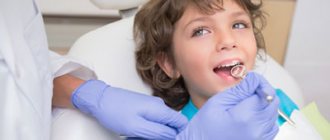Considering baby teeth to be something unworthy of attention is a dangerous parental misconception. Despite the fact that sooner or later they will change, it is necessary to protect them from caries, otherwise the child will not see a healthy smile in the future. Expert dentist Yulduz Gazizova tells how to take care of them
Since the rudiments of future permanent teeth in children are located under the roots of milk teeth, these first teeth should be preserved like the apple of your eye. And caries prevention should begin long before the baby’s first tooth erupts. And even before the child himself is born.
Content:
- Fluoride varnish
- Why use a fluoride-based protectant?
- Contraindications to the use of fluorine-containing varnishes
- Is it possible to use varnish at home?
- Carrying out the procedure in a dental clinic
- Important nuances
Enamel is the hardest tissue of the human body, but even it becomes thinner over time under the influence of a huge number of different factors.
The procedure of protective coating of teeth with a special varnish allows you to protect the outer shell of the unit and make it more durable. In addition, dental compounds used to treat the teeth of children and adults are a kind of antiseptics. They block the spread of pathogens and thus provide reliable caries prevention.
Most often, when providing a protective coating for teeth, dentists use fluoride varnish. This is a special viscous liquid, including fluorine and other related compounds.
What is dental sealing in children?
In order to prevent such problems, there is the so-called sealing of teeth in children - both milk and permanent. This is a process in which the dentist fills the fissures with a special compound - a sealant. It evenly and accurately fills all hard-to-reach and deep places where a toothbrush could not reach and will make the tooth surface even and smooth, improving the quality of cleaning many times over. The procedure is paid, but compared to the amount of money, nerves and time spent on treating caries, not to mention restoring a damaged tooth, it is worth the money.
Fluoride varnish
The composition of the varnish, which protects tooth enamel and prevents calcium leaching, includes:
- sodium fluoride;
- shellac;
- fir balsam;
- chloroform;
- ethyl alcohol, etc.
All these substances act in synergy - they provide high-quality disinfection of the treated surface and effectively strengthen it. When enamel comes into contact with sodium fluoride, a hard protective layer is formed. It is thanks to him that the unit ceases to be overly sensitive to salty, spicy and sour foods, and temperature changes.
The mixture has a positive effect on the condition of the gums. After its use, soft tissues become less inflamed and bleed less.
Why use a fluoride-based protectant?
Fluoridation is prescribed to young children to avoid tooth decay. After all, it is very important to keep the milk units healthy until they are replaced. How many years the molars will last largely depends on their condition.
Other indications for enamel coating include:
- Restoration of the natural mineral structure of hard tissues. Fluorine is able to “pull” the necessary minerals from saliva, due to which an active saturation reaction occurs.
- Prevention of premature crown wear. If the tooth is healthy, the problem of abrasion will not arise, so you need to monitor the condition of its tissues.
- High sensitivity. It can be hereditary or provoked by rough mechanical influences performed by dental procedures (for example, whitening).
- Wedge-shaped defect. With this diagnosis, tissue is destroyed in the cervical area. Moreover, the destructive process is in no way related to caries.
It is advisable to cover your teeth with a protective coating after professional ultrasonic cleaning. In general, this procedure will be useful to almost all patients of the dental clinic (with the exception of those who have contraindications to its implementation).
Removing doesn’t hurt!
If there is evidence for this, the dentist will suggest that the parents remove the baby tooth affected by caries. In this case, usually the root part of the pulp is left, and only the coronal part is removed. This measure allows you to avoid bite deformation.
Anesthesia during removal can be different: superficial, infiltration, application. Application anesthesia is carried out without an injection and is most often used, although it lasts only 10-20 minutes. For longer treatment, an injection will be required, and for surgical interventions, conduction anesthesia is used. If the doctor has no other choice (the child is too active, experiences a nervous breakdown, feels panicky), then it is possible to carry out treatment in his sleep (under general anesthesia).
Is it possible to use varnish at home?
It is allowed to carry out a strengthening procedure at home, but you should still consult a doctor first. Difficulties will arise already at the stage of purchasing varnish - you won’t be able to find a high-quality and safe solution on the open market. It must be ordered from a dental center or specialized medical store.
If you do find a drug and the dentist allows you to use it yourself, do not forget about the rules:
- pre-dry your teeth using cotton swabs;
- apply the product in a very thin layer;
- The varnish should dry naturally for about 5 minutes;
- Do not eat anything for twelve hours after the procedure.
Dangerous fast food and academic stress
Going to first grade, the child receives some “financial freedom” in the form of pocket money. And you know what they spend it on - on fast food. By the way, if a child constantly chews at school, perhaps he is simply stress-eating (school psychologists have a concept - “September neurosis”).
Ideally, it would be better to stop intercepting things on the way to and from school altogether. Breakfast at home, then second breakfast at school and lunch again at home. But in real life you can hardly do without snacks. The most dangerous for teeth are enriched carbohydrates, a tasty food for microbes. Therefore, the most common causes of caries are:
- chocolate and pseudo-chocolate bars, sweets, baked goods, ice cream;
- sweet drinks (even those that do not contain sugar, but its substitutes - they are not very healthy for children). This also includes sweet juices and coffee drinks with milk and sugar;
- instant soups and noodles with flavor enhancers.
So get your child used to snacks that are healthy for teeth: instead of a chocolate bar, put a peeled carrot or an apple in his backpack. And most importantly, create personal motivation in the child that if he takes care of his teeth now, he will grow up beautiful and successful.
Carrying out the procedure in a dental clinic
Dental treatment in a dental clinic is much more effective than at home.
Before proceeding with the manipulation, the doctor carefully cleans the dental crowns from hard stone and soft plaque. Due to this, the fluoridated gel adheres better to the enamel and penetrates into its deeper layers. Afterwards, the work area is isolated from saliva. This is very important and a person is not able to do this on his own. The dentist then uses fluoride varnish. He carefully distributes it over all surfaces, making sure that not a single area is left untouched. Until the solution dries, the person sits with his mouth open.
An experienced dentist knows exactly how much varnish to use and how to apply it correctly. Therefore, the patient does not risk anything. He can be confident in the effectiveness of the therapy.
Prevention of caries. Expert advice.
From the above, it is clear that sweets are not as bad as poor personal hygiene. The best prevention of caries is timely removal of plaque.
. There is no need to constantly visit a doctor for this. High-quality personal hygiene is available to us on our own. It is enough to follow a number of simple but very practical rules:
- Brush your teeth after every meal. Of course, this is not always possible in real life. If it is not possible to brush your teeth during the day after a “snack”, rinse them with water;
- Brushing your teeth at least 2 times a day (morning and evening) is MANDATORY. It is especially important to brush your teeth before going to bed, as little saliva is produced at night and practically nothing prevents the growth of bacteria. There is a sharp increase in the amount of acid released that affects the teeth, increasing the risk of developing caries;
- DO NOT EAT sandwiches. This is harmful not only for teeth, but also for the entire gastrointestinal tract, since proper wetting of food does not occur;
- Carbonated sweet water is very harmful not only to your teeth. Soda contains phosphorus or carbon dioxide in low concentrations, which provokes the leaching of calcium salts from the teeth. Due to this, the surface of the teeth becomes more susceptible to the action of bacterial acids, and plaque adheres to it better. If you cannot refuse your child soda, then at least let him drink regular still water after soda;
- Taffy, toffee, lollipops and lollipops should be excluded from the diet. They easily stick to teeth and take a very long time to dissolve, bringing a lot of joy to carious bacteria. THE LONGER SWEETS ARE IN THE ORAL CAVITY, THE HIGHER THE RISK OF DEVELOPING DENTAL CARIES;
The best prevention of dental caries is personal hygiene. By teaching your child to brush their teeth, you will protect them from decay.
Important nuances
In order for the use of a fluoride-containing product to be effective, it is important to remember some points:
- After manipulation, it is prohibited to use pastes containing fluoride. This leads to an excess of the component in the body and causes the development of fluorosis.
- Treatment can only be carried out according to medical prescription. Between procedures, intervals determined by the dentist on an individual basis should be maintained.
- Pregnant women are recommended to strengthen their enamel with fluoride. During this period, calcium is actively washed out of the expectant mother’s body. To keep it in your teeth, you need to coat them with varnish. But in case of severe toxicosis, fluoridation is strictly contraindicated.
- Fluoride varnish should be applied after removing braces, during breastfeeding, and after gum disease.
The manipulation can be performed for the first time when the child turns two years old. Then it is done according to indications. Adults should use a fluoride-containing composition at least once a year, immediately after professional oral hygiene.
When are children's teeth sealed?
The procedure is most effective at a time when children's teeth are not yet affected by caries. If the teeth have very deep and complex fissures, then almost immediately after eruption they begin to fill with microorganisms and food debris, after which caries develops very quickly, followed by tooth decay. Therefore, it is best to do the procedure immediately after the molars erupt. Typically, the first permanent molars appear at the age of 6-8 years, and the second - at 12-14 years. Immediately after their complete eruption, we can say that it is time to do this procedure.
Manipulations can also be performed on baby teeth. Even small children tolerate them well.
What is the procedure for sealing teeth in children?
Before the procedure, you need to visit a dentist for a consultation on how exactly to seal your child’s teeth and whether it is absolutely necessary to do this. The doctor will conduct a thorough examination and evaluate the positive effect of such manipulations, determine the exact cost of the procedure and materials needed in your case.
The procedure itself is absolutely painless, but both local and injection anesthesia are possible. In newly erupted teeth, the fissures are very narrow, soft and deep due to incompletely formed enamel, which contains much less essential minerals. This almost guarantees that by the time you visit the dentist, certain food debris has already accumulated in them and will need to be removed. The procedure is performed with special equipment.
After cleaning, the tooth is filled with a sealant - a self-hardening sealant that fills empty spaces, hardens and thus prevents the penetration of microorganisms and food debris into them. In addition, the tooth becomes much easier to clean, which creates additional protection.
After cleaning the tooth with all necessary means, the dentist clears the oral cavity of saliva using special rollers and equipment. A special composition is applied to the tooth to facilitate the adhesion of the sealant to the surface, after which the tooth is dried and the sealant itself is applied to it. Due to its fluidity, it is perfectly distributed over the entire surface of the tooth, filling even the narrowest and deepest fissures and making the tooth completely protected from harmful factors.
After the sealant has completely filled the grooves, the dentist uses a special lamp to cure it, or waits a while when using a self-curing agent. The main thing after hardening is the absence of discomfort when closing the jaws. The doctor checks this with special paper and, in the case of too much material, removes it with special rotating devices, which is also absolutely painless. After completing the entire procedure, the tooth is coated with a special varnish or gel.
Sealants can be different both in their properties and in cost. They often contain fluoride to better strengthen tooth enamel, so in addition to the barrier value, the procedure also has hygienic and preventive purposes.
Which fissures need to be “sealed”?
The thinnest and deepest. After all, the thinner and deeper the fissure, the more difficult it is to clean; the most difficult ones are not cleaned at all. In addition, the sealant penetrates best into thin and deep “pits”, therefore, the thinner and deeper the area being filled, the more successful and useful the procedure.
All this applies to the posterior chewing teeth, since they usually have the narrowest and deepest “grooves.” Such teeth require the creation of a barrier that will protect them from the adverse effects of microorganisms, acids and the environment.
Only the dentist himself can determine what needs to be sealed and what is optional. He conducts an examination to identify deep fissures.
Do all fissures in children need to be sealed?
There are fissures on all posterior chewing teeth. However, not all of them are pronounced; there are also open fissures that can be easily cleaned with a toothbrush, and there is no need to carry out this procedure on them. Still, sealing teeth in children is an intervention and if it is not required, you should not do it just like that.
However, if at the time of preparation for sealing caries has already appeared inside the fissures or on the teeth themselves, then it is necessary to carefully get rid of it by sanding the affected areas and treating these places with a special compound.
How long will the effect of the procedure last?
For about two to three years, the sealant will reliably protect the child’s teeth from microorganisms. However, it is necessary to see a dentist twice a year to monitor the condition of teeth in general and sealed baby or permanent teeth in particular. In general, as practice shows, even after 5-10 years, the sealant completely protects the tooth from acids and caries.
It is considered that the procedure was carried out correctly and successfully if the sealant on the tooth has been preserved well for 3-5 years. However, even if it lasted less, it is necessary to remember that protecting the tooth from caries all this time was worth it.
Reviews about sealing teeth in children
At the moment, reviews from both doctors and patients indicate that sealing baby and permanent teeth in children is a procedure that, with almost complete absence of negative aspects, is exceptionally effective in protecting the posterior chewing teeth from caries and destruction. This is exactly the case when, with a correctly performed sealing procedure for both primary and permanent teeth in children, everyone remains satisfied: doctors, parents, and young patients.
To keep your teeth healthy even longer, use the right toothpastes. Asepta products from the Baby, Kids and Teens series will protect and strengthen the enamel, keeping teeth snow-white and strong. They are designed taking into account age-related needs, replenish the lack of minerals in the enamel, and protect the oral cavity from acids. At the same time, our pastes have a pleasant taste that children like!
Take care of your family with Asepta!

